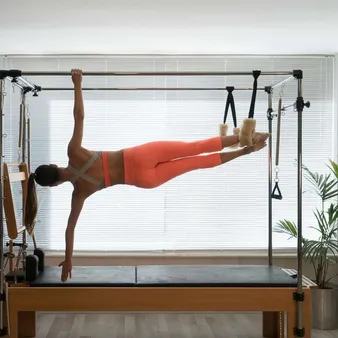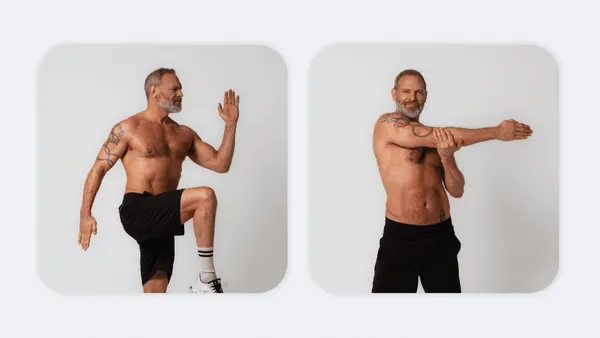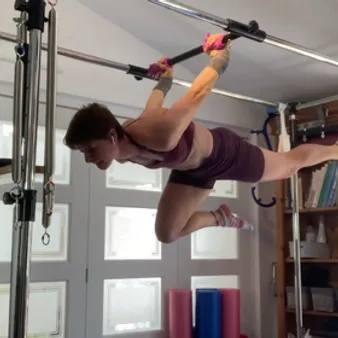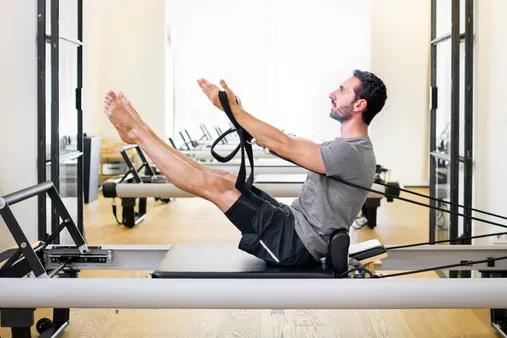Table of Contents
calisthenics and pilates are two popular forms of exercise that can help you improve your strength, flexibility, and overall fitness. Calisthenics uses bodyweight exercises to build muscle and burn fat, while Pilates focuses on core strength, flexibility, and balance. Both calisthenics and Pilates can be done at home or in a gym, and they are suitable for people of all ages and fitness levels. If you're looking for a challenging and effective way to get in shape, calisthenics and Pilates are great options. You can find more information about these exercises on our website, Kizworld.
Calisthenics and Pilates: A Synergistic Journey Towards Fitness Enlightenment
Feature | Calisthenics | Pilates |
|---|---|---|
Equipment | No equipment necessary | May use mats, reformers, and other equipment |
Focus | Compound movements, bodyweight exercises | Core strength, flexibility, and balance |
Intensity | Can be high-intensity, depending on exercises | Typically low-intensity, with emphasis on form |
Skill Level | Suitable for all levels, with modifications available | May require some prior experience for certain exercises |
Benefits | Improved strength, endurance, and coordination | Enhanced posture, flexibility, and body awareness |
I. Calisthenics: The Ultimate Bodyweight Workout
What is Calisthenics?
Calisthenics is a form of exercise that uses bodyweight as resistance. It is a great way to build strength, endurance, and flexibility. Calisthenics exercises can be done anywhere, making them a convenient and accessible form of exercise.
Benefits of Calisthenics
There are many benefits to calisthenics, including:
- Improved strength and endurance
- Increased flexibility
- Reduced body fat
- Improved cardiovascular health
- Reduced risk of injury
Getting Started with Calisthenics
If you are new to calisthenics, it is important to start slowly and gradually increase the intensity of your workouts. There are many different calisthenics exercises that you can do, so it is important to find ones that you enjoy and that challenge you.Here are a few tips for getting started with calisthenics:
- Start with bodyweight exercises that you can do with good form.
- Gradually increase the intensity of your workouts by adding more repetitions or sets.
- Listen to your body and rest when you need to.
- Have fun! Calisthenics is a great way to get in shape and have fun at the same time.
If you are looking for a challenging and effective way to get in shape, calisthenics is a great option. With a little effort, you can achieve your fitness goals and have fun at the same time.How to Do a Muscle Up
Exercise | Difficulty | Equipment |
|---|---|---|
Pull-up | Beginner | Pull-up bar |
Push-up | Beginner | None |
Squat | Beginner | None |
Lunge | Beginner | None |
Plank | Beginner | None |
The Best Calisthenics Gifts and Accessories
Calisthenics: The Ultimate Bodyweight Workout
II. Pilates: The Mind-Body Connection
History of Pilates
Pilates was developed by Joseph Pilates in the early 20th century. Pilates was originally called "Contrology" and was designed to help rehabilitate injured dancers. However, Pilates quickly became popular as a way to improve overall fitness and well-being.Today, Pilates is practiced by people of all ages and fitness levels. Pilates is a low-impact exercise that can be modified to meet the needs of each individual. Pilates exercises focus on core strength, flexibility, and balance.
Benefits of Pilates
Pilates offers a number of benefits, including:* Improved core strength* Increased flexibility* Enhanced balance* Reduced stress* Improved posture* Reduced pain* Better sleep* Weight loss
Benefit | Explanation |
|---|---|
Improved core strength | Pilates exercises focus on strengthening the core muscles, which are responsible for stability and balance. |
Increased flexibility | Pilates exercises help to lengthen and stretch the muscles, which can improve flexibility and range of motion. |
Enhanced balance | Pilates exercises help to improve balance by strengthening the core muscles and improving proprioception, which is the body's sense of where it is in space. |
Pilates: The Mind-Body Connection
III. Calisthenics vs. Pilates: Which Is Right for You?
Calisthenics and Pilates, both known for their distinct approaches to fitness, offer unique advantages that cater to different preferences and goals. Delving into the nuances of each discipline can guide you towards the optimal choice for your individual needs.
Fitness Objectives and Goals
Calisthenics harnesses bodyweight as resistance, emphasizing compound movements that engage multiple muscle groups simultaneously. This dynamic approach fosters strength, endurance, and coordination, making it especially appealing for those seeking a well-rounded physical challenge. On the other hand, Pilates prioritizes core strength, flexibility, and balance through controlled, precise exercises. This mind-body practice caters to individuals aiming to improve posture, enhance flexibility, and cultivate a strong core.Learn more about the distinctions between Calisthenics and other fitness disciplines.
Skill Level and Prior Experience
Calisthenics offers a versatile spectrum of exercises, accommodating both beginners and seasoned athletes. Modifications and progressions allow individuals to gradually advance their training, making it accessible to all fitness levels. Pilates, while generally appropriate for beginners, may require some prior experience for certain advanced exercises that demand greater flexibility and body awareness.
Recommended for Related Posts:
- How to Get Started with Calisthenics as a Beginner
- Mastering Basic Calisthenics Skills and Progressions
Personal Preferences and Enjoyment
Ultimately, the best choice between calisthenics and Pilates boils down to personal preferences and enjoyment. Calisthenics appeals to those who relish dynamic, high-intensity workouts that challenge their physical limits. Pilates, conversely, resonates with individuals who favor a more controlled, introspective approach that emphasizes body awareness and precision.
Feature | Calisthenics | Pilates |
|---|---|---|
Focus | Compound movements, bodyweight exercises | Core strength, flexibility, and balance |
Intensity | Can be high-intensity, depending on exercises | Typically low-intensity, with emphasis on form |
Mind-Body Connection | Less emphasis on mind-body connection | Strong emphasis on mind-body connection |
Hybrid Approach
Consider blending calisthenics and Pilates for a comprehensive workout that amalgamates the benefits of both disciplines. This hybrid approach allows you to leverage the strength-building prowess of calisthenics while enhancing your flexibility, balance, and core strength through Pilates.Discover how to combine Calisthenics and Pilates for optimal results.
Calisthenics vs. Pilates: Which Is Right for You?
IV. Combining Calisthenics and Pilates for a Complete Workout
Calisthenics and Pilates are two popular forms of exercise that can offer a wide range of benefits. Calisthenics focuses on bodyweight exercises, while Pilates emphasizes core strength, flexibility, and balance. By combining these two disciplines, you can create a well-rounded workout routine that targets all aspects of fitness.
One of the main benefits of combining calisthenics and Pilates is that it can help you improve your overall strength and conditioning. Calisthenics exercises such as push-ups, squats, and pull-ups can help you build muscle and strength, while Pilates exercises such as planks, bridges, and roll-ups can help you improve your core strength and stability.
Calisthenics | Pilates |
|---|---|
Focuses on compound movements and bodyweight exercises | Emphasizes core strength, flexibility, and balance |
Can be high-intensity, depending on the exercises | Typically low-intensity, with emphasis on form |
Another benefit of combining calisthenics and Pilates is that it can help you improve your flexibility and mobility. Calisthenics exercises such as lunges, squats, and stretches can help you increase your range of motion, while Pilates exercises such as the cat-cow stretch, the bird dog, and the roll-up can help you improve your flexibility and mobility in your spine and core.
Finally, combining calisthenics and Pilates can help you improve your balance and coordination. Calisthenics exercises such as handstands, planches, and levers can help you improve your balance and coordination, while Pilates exercises such as the single-leg bridge, the side plank, and the toe taps can help you improve your balance and coordination in your core and lower body.
Combining Calisthenics and Pilates for a Complete Workout
V. Conclusion
Calisthenics and Pilates are both excellent forms of exercise that can provide a wide range of benefits. They are both low-impact, making them suitable for people of all ages and fitness levels. They can be done anywhere, with no special equipment required. And they are both fun and challenging, so you are more likely to stick with them. If you are looking for a way to improve your overall fitness, calisthenics and Pilates are both great options. They can help you build strength, flexibility, and endurance. They can also help you lose weight, improve your posture, and reduce your risk of chronic diseases. So what are you waiting for? Give calisthenics and Pilates a try today!